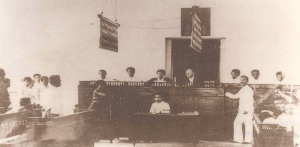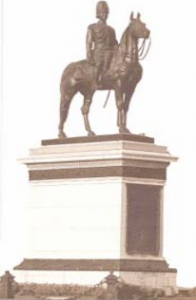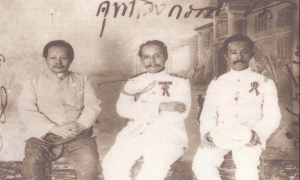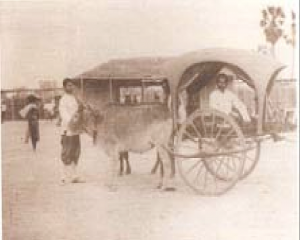
Prince Damrong Rajanubhab on a tour of inspection in E-san (the Northeast) Circle (Monthon), Ubon Ratchthani Province in 1906
In spite of our proud and pleasure in 1892, as the government officers of the Ministry of Interior, towards the crucial roles of the ministry in national history, when the ministry was newly established, there were only three staffs, namely, Senabodi, Phra Montri Potjanakij, and I. Senabodi and I knew French. I was also the only person accustomed to the frontier as I once visited there during the process of generating a map. At first, I was new to the ministry and felt unfamiliar to everyone. Most of them were only acquainted with Bangkok, but they had no idea about distant cities, especially the borderland. I couldn’t imagine how they would understand French or tensions along the east and west of the border that we had to argue with them at that time.
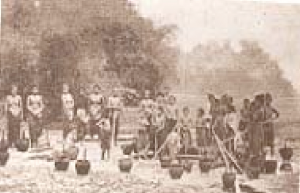
Living conditions of people in E-san Circle during the reign of King Rama V when Prince Damrong Rajanubhab went on a tour of inspection in 1906
Almost a year after taking a position, the “Franco-Siamese War” took place around Mekong river basin in 1893. H.R.H. Prince Prachaksinlapakhom served as the Commissioner General of Ban Duea Mak Khaeng (Udonthani nowadays), called “ the Lao Phuan Commissioner” while the area of Lao Kao and Ubon Ratchathani were in charge of Prince Phichit Prichakon, called “the Lao Kao Commissioner”. Another troop of the Lao Kao Commissioner was at Champasak, governed by Phra Phisnu Thep. All of them hadn’t realised the vision and policy of the ministry. We were only able to inform the situation to the king and follow his decision over and over again. His Majesty had extremely been exhausted staying up in the office day and night until peace was found.
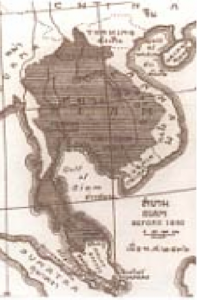
Map reveals the territory of Thailand in 1893
The communication among the provinces in the Mekhong region must be by horses or on foot. There were absolutely no planes, trains, post, or telephones. Fortunately, I had known a number of officials and been very adept from travelling a lot in these areas during my survey trip for creating map. I, thus, was able to plan a good and fast means of communication by arranging people and mounted scouts. For instance, it could reach Nong Khai and Ubon Ratchathani within 4-5 days which was very effective. After negotiated with France over the Mekong region, Ministry of Interior also had to cope with the issue with France at Chanthaburi province because Phraya Wichayathibadi (Swassi Bunnag) ( a brother of Somdet Chaophraya Borom Maha Sri Suriwongse (Chuang Bunnag) and father of Phraya Dechanuchit Phraya Sri Thammasokraj), an old officials at the Ministry of Interior was sick. I had to go to Chantaburi immediately, risked bullets to French Army Installation to see a French commander in chief and settled dispute with France successfully. The king was then sick and cured at Si Chang Island since there were enough accommodation for Somdej Phra Senabodi who followed. Phra Montri Potjanakit and I had taken turn to be stationed at the ministry and travelled a round trip, Bangkok – Si Chang in order to present official reports and update news about the border to senabodi before taking orders to implement. Apparently, every day, the trip on royal navy from Bangkok to Si Chang Island was taken 8 hours through storms. Ten officials could only help with writing but they had no idea about borders and foreign affairs. This made me and Phraya Phra Sadej, my friend at school whom my mother really adored, loved each other like relatives.
In regard to the difficult tasks of interior affairs that government officers had to undertake, the Franco-Siamese War of 1893 must be totally remembered. Thailand had to set up a temporary special tribunal to judge a case that French solider was beaten to death and those Thai people who broke the laws at Thung Chiang Kham, Kaeng Jek, and Kham Muan, dated 7th of February, 1893, published in Government Gazette Vol.10, Page 499 on 11th February, 1893. Krom Luang Pichaipreeyakorn was appointed for a chief judge together with 6 officials (Phraya) to serve as deputy chief judges. To be more exact, these 6 Phraya consisted of 1 solider, 1 police, 1 Krom Mahad Lek (chamberlain namely, Chao Phraya Thewet), Phraya Rittirong Ronnachet (a government officer from Ministry of Interior), and 2 judges from Ministry of Justice. Two Thai lawyers knew foreign languages namely, Luang Sunthorn Kosa (Koyule Na Ranong) or Phraya Pradibhatbhubarn and Hussabumroe Humprae (name of a rank of royal pages) namely, Chao Phraya Sutham Montri (Pluem Sucharitkul), a father of formerly Queen Indrasakdi Sachi.
Trial process in the Royal Criminal Court, the defendants subjected to a foreign country so the consulate also joined in the magistracy
This dual court was consisted of Thai and French judges, six from Thailand as mentioned earlier while the number of French judges was more than a half of Thai side. This case, the key defendant was Phra Yot Mueang Kwang, Thai government official who worked at Kaeng Lee Phee in Sithandon, close to Champasak province. The point I would like to convey here is Phra Yot Mueang Kwang was under Ministry of Interior as an assistant commissioner (Ka Luang) in Champasak (Commissioner of Monthon Lao Kao at that time). When the government official under Ministry of Interior became the defendant, the ministry had to appoint someone to attend a court hearing which it was disgraceful that no one was willing to go. Prince Damrong Rajanubhab said to me that “You are the Ministry of Interior official who speaks and understands western customs. Please attend the trial on behalf of a representative of the ministry.” I really didn’t want to go but couldn’t deny. I went to the court every day until the final judgement and made a report following the government regulations.
Remembered that the court was on the second floor in front of French Embassy, located by Chao Phraya River (French Bank nowadays), this provided a clear view in the river when two French warships were attacking the estuary of the Chao Phraya River, firing at the Chulachomklao Fort and Samut Prakan on 13th July, 1893. Also, at the river pavilion in front of the special court, French navy armed with the weapons based to watch over the trial. This was one thing that officials of Interior had been forced to do.
As a result, during the time I had served as the government official since 1892 onwards, Lucky for Thailand that we had the great king with comprehensive wisdom and diligence so that Chulalongkorn (King Rama V) earned the epithet “Phra Piya Maharat”. The political situation at that time, Thailand needed to be highly involved with foreign countries as a lamb and wolves but the nation survived because of the ability of the king and minister of the Interior. Moreover, Prince Devawongse Varoprakar (Thewan Uthaiwong), a statesman who specialised in politics, especially foreign affairs, was calm, gentle, and respectable. He had served as the minister of Foreign Affairs longer than anyone else, and for that reason that foreign affairs had always been a regularly work in the city. Then, there was only little opportunity to see the provinces. Therefore, no matter how difficult the political situation of those days, but it was a fortunate thing for Thailand, as the Westerners like to use the term, “Heaven helps” was that we had His Majesty King Chulalongkorn, Prince Devawongse Varoprakar (Thewan Uthaiwong) as the Minister of Foreign Affairs and Prince Damrong Rajanubhab as the Minister of Interior as if all these positions were three main poles to overcome all obstacles and uphold the nation for prosperity and unity. After three of his highness had already passed away, the latter rulers also succeeded in protecting and developing the country prosperously until 1932. We, Thai people, should be pleased and harmonious to preserve the nation as our ancestors had done for our next generation.
The Equestrian Statue of King Chulalongkorn, Krom Phraya Damrong Rajanupab, thought of raising funds to build it since he was still alive in honour of His Majesty the King Rajamangala Phisek Ceremony (1908), also the one who gave the royal nickname “Piya Maharat”
His Majesty King Chulalongkorn took a photograph with Somdej Krom Phraya Devawongse Varoprakar and Somdej Krom Phraya Damrong Rajanubhab at the royal photography studio in the annual event of Benchamabophit Temple, 1903 with the royal speech that “my left and right hand man, let take pictures together”

